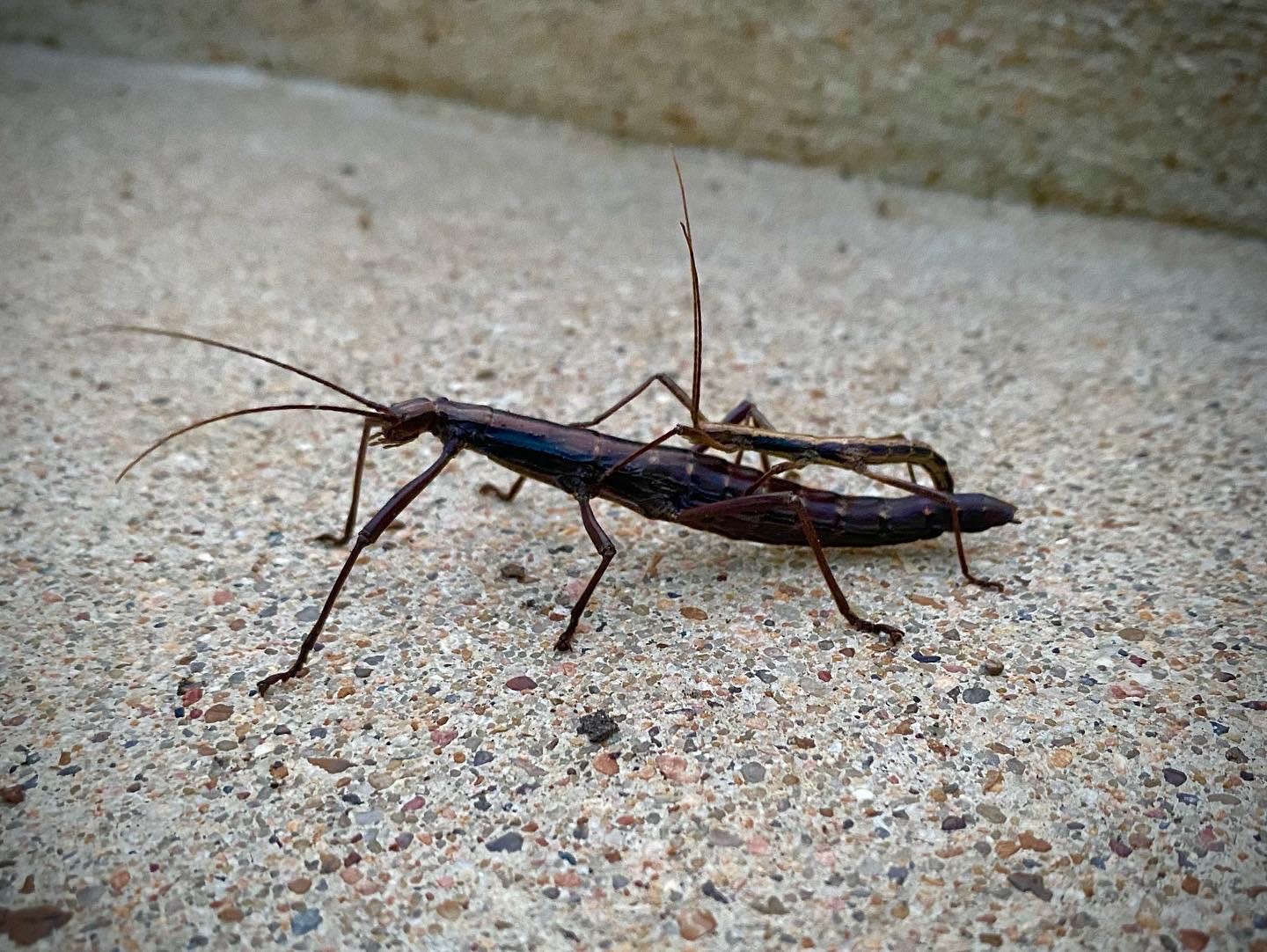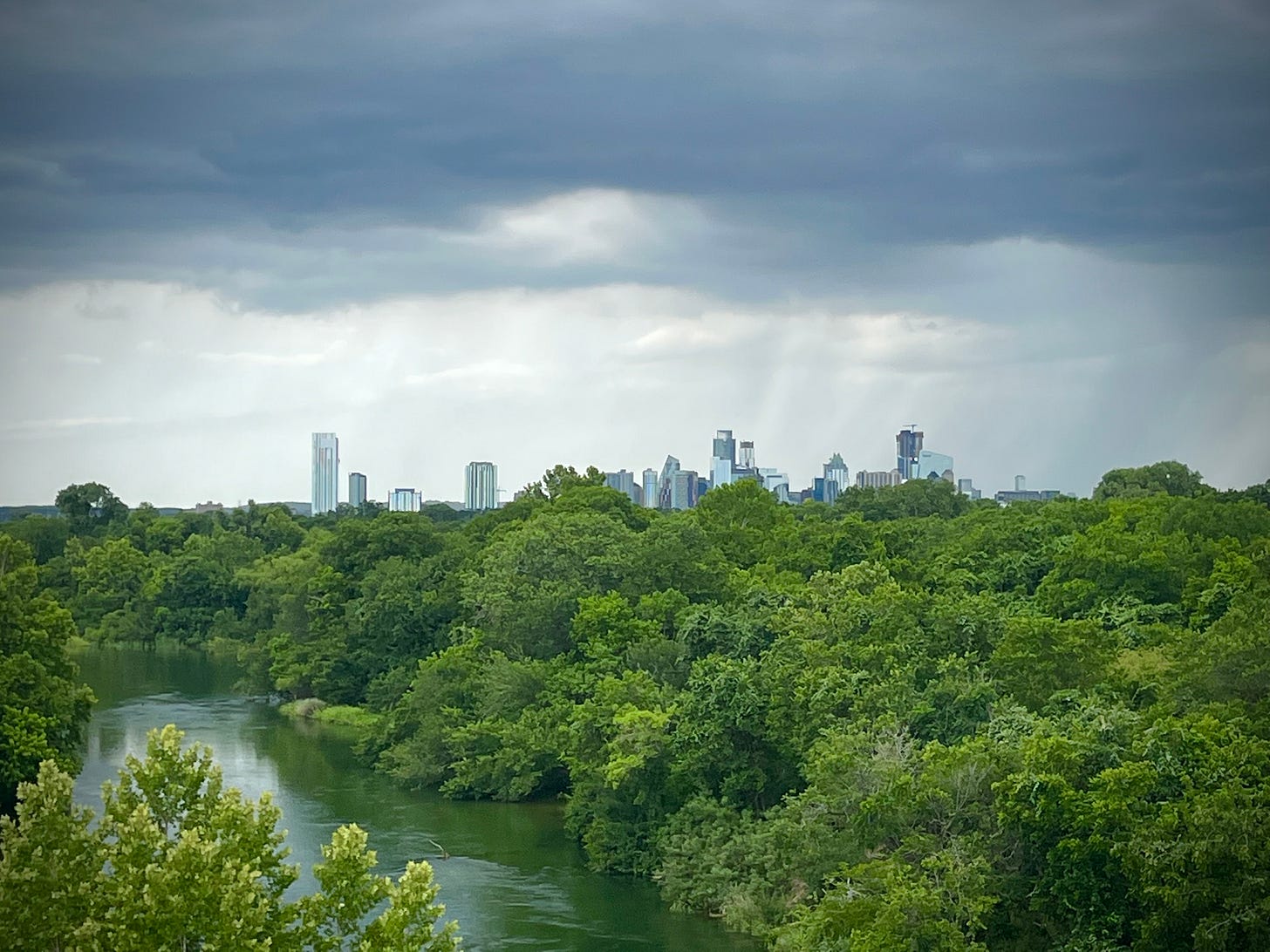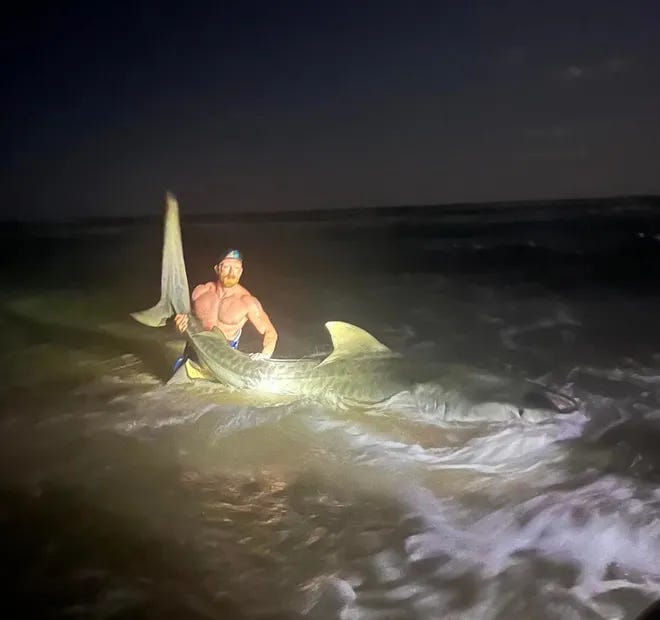At the wild Phasmid rodeo
The season of the Devil Riders announced its arrival with the pair of Phasmids I found copulating on the back of my neck on Memorial Day. I’m not sure what foliage I must have shoved my head into to cause their transference unto me as I weeded, but they are so prodigious here in our yard gone wild that I knew what they were before seeing them, from the weirdly plump chitin I felt in my fingers as I brushed them off.
The females, who are about as long as one of your fingers and almost as thick, are the ones who earned Anisomorpha buprestoides the name Musk Mare among earlier generations of Americans who encountered these strange creatures in the country they had just stolen. They were also sometimes called the Witch’s Horse. The cowboy-era settlers adopted so many equestrian analogies because these walking stick bugs are most often seen with the diminutive male on the back of the female, usually for many days, as the insecure inseminators try to block any potential competitors long after the main work has been done. My wife and I have had a decade of constantly having to nudge them from the jambs of our doorways, and are still learning some of their secrets and lore.
A Google search for the origin of the name Musk Mare mostly returns articles about Elon’s mom, making me wonder if there is some lizard people-like connection there. But the likely reason is the female’s special power to shoot a malodorous cyclopentanyl monoterpene dialdehyde compound from a pair of glands at the front of her thorax, a spray that can be accurate as far as five feet away, often aimed at the eyes of its threat, and capable of causing temporary blindness in humans. So far, we have not been sprayed, perhaps because these indigenous inhabitants of the parcel we have colonized believe us when we say we come in peace.
It took the imminent arrival of my niece and nephew to get me to attend to some of the clean-up of our feral homestead that a season busy with work and toddler wrangling had provided plentiful excuses to defer. Our roof is a Blackland prairie restoration that hangs down over our windows, the rest of our yard an ever-changing riverine grove, and in spring and early summer if you don’t keep it somewhat in check at the margins it will soon seem ready to devour you. One of its inhabitants actually did bite me, as I swept the leaf litter out from behind a patio bench and soon found the source of the sudden sharp pain in my foot: a spider in my clog, little and tawny enough to incite worries it might be a brown recluse, one of the Texas killers I have never actually encountered.
Further confirmation of utopia’s elusiveness came with the accumulating evidence that the four beautiful cardinal eggs nested in an ornamental tree outside our bedroom door had been abandoned. The mama had dutifully tended them for what seemed like well over three weeks, and she must have known that the time in which they would have hatched if they could had passed. We wondered if the spot was too hot, there on a concrete patio facing the southern sun of late afternoon. And then we got to wondering about our hotter future, and whether even these red birds we see everywhere we look all year long will someday be hard to find.
When I was a kid, on Memorial Day we would drive out to the country cemetery where the Iowan ancestors who fought in the Union Army were buried, a ritual that you could feel traced back to the holiday’s original observance by people who lived through the Civil War. It gave the holiday a solemnity even a clueless young boy could appreciate, an overhang of dark grief caught up in national politics that has always stuck with me. Our kids get to enjoy a day without school and fun in the pool, which is probably a better way to commemorate the beginning of summer.
As I finished sweeping the patio and got ready to light the grill, I noticed one of the weird little found objects I keep around the house had fallen from its spot above the breaker box by our front steps and broken. One of many old plastic toys I have found in the yard over the years, from the long decades when this was an empty lot and outlaw dumpsite. An old cap gun with a picture of a cowboy conquering the desert landscape and the trademarked moniker WILD WEST. I had kept it there close to the entry, a winking talisman that pantomimed protection while also expressing my association of the gun with juvenile power fantasies among those who do not need them for their work, or to put food on the table. A serendipitous week in which to find a broken rifle in one’s path, on the holiday rooted in contemplation of the deaths we inflict on our neighbors.
The day before we had walked over the bridge to the playground across the river, but by the time we got there our poor old dog was so exhausted I needed to get her home. So she and I took the shortcut, off the pavement, into the woods, and into the clear cool water of the urban river where it flows below the dam that holds in Austin’s downtown lake.
We hadn’t been down in that stretch for a few weeks, and were amazed to see that the swampy side channel that a year ago this time was full of juvenile herons learning to fish has turned into a lush alley of native switch grass, its formerly wide canal narrowed to a muddy little creek. At its source, where the main channel widens into fast burbling shoals just before the bridge, even the eroded bluff cut from an old hippie campground by the river’s aggressive meander was turning green. A promising sign in dry times, even as I wondered how it might impact the kingfisher habitat.
The river is one of the main collectors of the crap we leave outside, and this stretch where we live was at the edge of town until fairly recently. The zone where we walked was mined by gravel operations into the Seventies, and if you pull up old maps you can see how razed it was by industrial activity back then. Sixty years ago it was the site of one of the worst fish kills in American history, chronicled in Rachel Carson’s Silent Spring. To be able to walk in it now, surrounded by lush riparian woods on either side, and experience a zone so seemingly wild that you could believe you are as far as possible from the fastest growing city in America, is a minor miracle, and a powerful example of how quickly natural systems can recover with a mix of intention and inattention from the humans who live around them.
For a moment in that glorious light, color and flow, walking in the knee-deep water that provides precious habitat in the shadows of downtown, you could almost believe in the possibility of a future where we learn to really share our domain with the other creatures we have long displaced. Until you are reminded that we can’t even share it with each other, ruled over by men as insecure in their status as those diminutive Devil Riders. And when the rain finally rolls in at the end of a hot day in the late Anthropocene, you could be forgiven for thinking of all those stories our ancestors passed down about the big floods that come to cleanse the world of our sins.
Reading roundup
Welcome to all the new subscribers who found their way here the past couple of weeks. Field Notes is a weekly newsletter of writing about urban nature and other things, mostly drawn from observations around the area where we live in the eastern edgelands of Austin, Texas, sometimes ranging more widely. I began the project in February 2020 as an experiment in what some have called “dystopian nature writing,” and it has drawn a wider readership and shown more legs than I expected. If you’re interested in my fiction or other writing, you can visit my main site. And if you’d like to get a better picture of the zone where we live, you can check out this documentary on Apple TV’s HOME, this Ted-like talk for Nerd Nite Austin, or this recent magazine profile. I’m working on a book that draws on the same material as this newsletter, and hope to have more news about that soon.
My first novel, Tropic of Kansas, tried to grapple with the Second Amendment as the third rail of American politics, endeavoring to repurpose its revolutionary dreams and the violent and often juvenile impulses of our pulp fiction toward more emancipatory ends. An effort at exorcism that writes around the real issues, ultimately tying them to the dark ecology that underpins our damaged culture. For writing that bites right into the issues evident in the horrors of Uvalde that we are still coming to terms with, in a fortnight when there seems to be another incident every other day, I’ll recommend two excellent articles: Christopher Hooks at Texas Monthly, trenchantly situating the shootings in the context of Texas political leaders’ self-professed focus on “protecting children,” and Seamus McGraw at the Texas Tribune, tracing all of our mass shootings back to the UT Tower in 1966.
Between all that news, and the latest on Jodie Foster’s army, the papers the past week have had a surprising number of stories of urban animal encounters. As one who took his son night fishing a few times in the gnarly surf of the Texas coast, but never caught much, I was especially enamored of this Corpus Christi Caller-Times story about Kyle resident Christian Haltermann, who took his 8-year-old out to put their lines in at Padre Island and, after his son enlisted the help of two nearby campers, brought in a 12.5-foot tiger shark, which they promptly released.
It’s good to know fish that size are still out there in the mess we have made of the Gulf. Especially after reading Ashley Dawson’s Extinction, an incisive critique that marries ecology with radical political economy. The book is one of many excellent new works of environmental writing from OR Books, with a fresh take on the natural history question embodied in the title of Paul Colinvaux’s classic work of ecology, Why Big Fierce Animals are Rare.
If you would rather escape into some good science fiction, our friend and neighbor Jessica Reisman has a wonderful story, “Aconie’s Bees,” in the new issue of Analog. It’s great to see a fabulist like Jessica find her work welcomed in the organ of “hard science fiction,” and this editorial interview with her is a great catch-up. You can find Analog at any bookstore with a newsstand, or directly from the publisher.
In other news, the Alamo vine is in bloom:
Have a safe week.













"I’m working on a book that draws on the same material as this newsletter" I'd love to read a book built around the ideas explored in this newsletter. I'd be especially interested in possible "seeds" of a better future that you have found in your walks and readings.
Another fascinating read. I look forward to seeing Field Notes weekly.